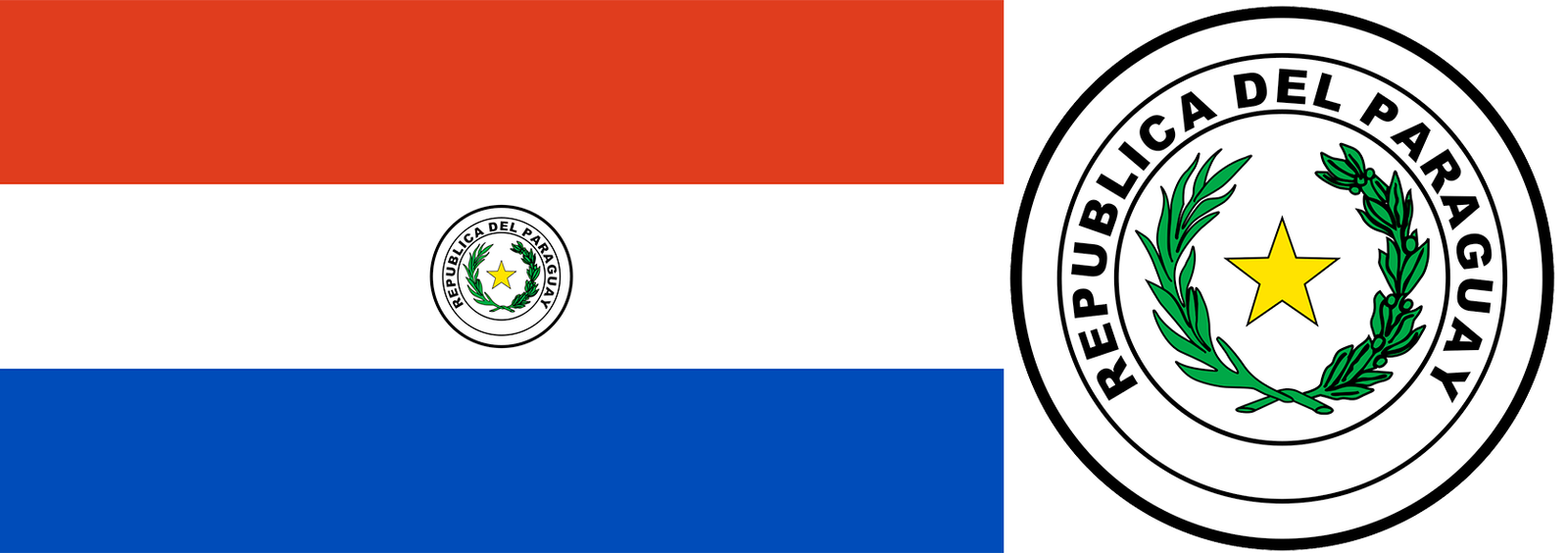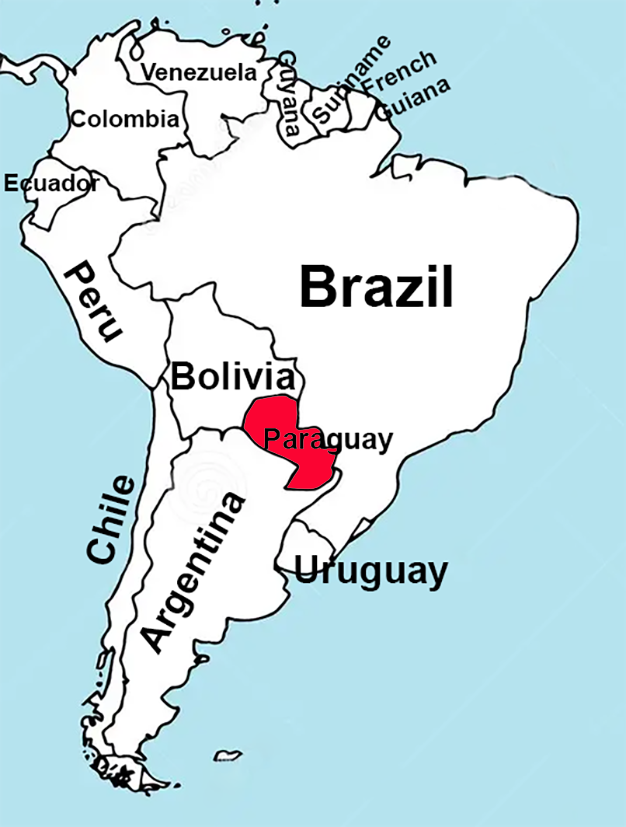FabulousFusionFood's Paraguayan Recipes Home Page
 The flag of Paraguay (left) and the coat of arms of Paraguay (right).
The flag of Paraguay (left) and the coat of arms of Paraguay (right).
Welcome to the summary page for FabulousFusionFood's Paraguayan recipes, part of South America. This page provides links to all the Paraguayan recipes presented on this site, with 9 recipes in total.
This is a continuation of an entire series of pages that will, I hope, allow my visitors to better navigate this site. As well as displaying recipes by name, country and region of origin I am now planning a whole series of pages where recipes can be located by meal type and main ingredient. This page gives a listing of all the Paraguayan recipes added to this site.
Paraguay, (República del Paraguay in Spanish; Paraguái Tavakuairetã in Guarani), officially the Republic of Paraguay, is a landlocked country located in the central region of South America. It is a unitary state with a territory composed of a capital district and seventeen departments. Its capital and largest city is Asunción.
Paraguayan cuisine has a marked influence of the Guaraní people combined with the Spanish cuisine and other marked influences coming from the immigration received by bordering countries such as Italian cuisine and German cuisine. The city of Asunción is the epicenter of the distinctive gastronomy that extends in current Paraguay and its areas of influence, which is the reason why is considered the mother of the gastronomy of the Río de la Plata. It is worth clarifying that in the Paraguayan society, the exchange of knowledge between mestizos, creoles and cario-guaraní people occurred before the Jesuit missions.
Paraguay, officially the Republic of Paraguay, is a landlocked country located in the central region of South America. It is a unitary state with a territory composed of a capital district and seventeen departments. Its capital and largest city is Asunción. Paraguay is a presidential republic and a state governed by the rule of law. It is a founding member of Mercosur, along with Argentina, Brazil and Uruguay.
 Location of Paraguay in South America with the land mass of Paraguay
Location of Paraguay in South America with the land mass of Paraguay
picked out in red.Spanish conquistadores arrived in 1524, and in 1537 established the city of Asunción, the first capital of the Governorate of the Río de la Plata. During the 17th century, Paraguay was the centre of Jesuit missions, where the native Guaraní people were converted to Christianity and introduced to European culture. After the expulsion of the Jesuits from Spanish territories in 1767, Paraguay increasingly became a peripheral colony. Following independence from Spain in the early 19th century, Paraguay was ruled by a series of authoritarian governments. This period ended with the disastrous Paraguayan War (1864–1870), during which the country lost half its prewar population and around 25–33% of its territory. In the 20th century, Paraguay faced another major international conflict—the Chaco War (1932–1935) against Bolivia—in which Paraguay prevailed. The country came under a succession of military dictators, culminating in the 35-year, U.S.-backed regime of Alfredo Stroessner, which lasted until his overthrow in 1989 by an internal military coup. This marked the beginning of Paraguay's current democratic era.
Paraguay is a developing country, ranking 105th in the Human Development Index. It is a founding member of Mercosur, the United Nations, the Organization of American States, the Non-Aligned Movement and the Lima Group. Additionally, the city of Luque, in metropolitan Asunción, is the seat of the South American Football Confederation.
While it is the only landlocked country in South America besides Bolivia, Paraguayan ports are able to access the Atlantic Ocean via the Paraná–Paraguay Waterway. The majority of Paraguay's 6 million people are mestizo, and Guarani culture remains widely influential; more than 90% of the population speak various dialects of the Guarani language alongside Spanish. Paraguay's GDP per capita PPP is the seventh-highest in South America. In a 2014 Positive Experience Index based on global polling data, Paraguay ranked as the 'world's happiest place'.
Etymology: The origin of the name Paraguay is uncertain. One version postulates the name takes from Guaraní paraguá 'feather crown' and y 'water' thus paraguaí 'feather crown of waters'. Other versions affirm that the name derives from the Payaguá people, for the Paraguay River was called the Payaguá-y, or 'river of the Payaguás' by the Guaraní and hence would have come the name for the country; or that, also from the Guaraní, para would mean sea, gua, originates, and y, river, thus Paraguay would mean 'river which gives birth to the sea'.
Meat, vegetables, manioc, maize, and fruits are common in Paraguayan cuisine. Barbecuing is both a cooking technique and often a social event, and are known as the Asado. Many dishes are based on corn, milk, cheese and meat, and fish caught in rivers are also eaten. There are about 70 varieties of chipa (cake) in Paraguay. Most chipas are made from manioc flour, which is derived from cassava, and cornmeal.
This is a continuation of an entire series of pages that will, I hope, allow my visitors to better navigate this site. As well as displaying recipes by name, country and region of origin I am now planning a whole series of pages where recipes can be located by meal type and main ingredient. This page gives a listing of all the Paraguayan recipes added to this site.
Paraguay, (República del Paraguay in Spanish; Paraguái Tavakuairetã in Guarani), officially the Republic of Paraguay, is a landlocked country located in the central region of South America. It is a unitary state with a territory composed of a capital district and seventeen departments. Its capital and largest city is Asunción.
Paraguayan cuisine has a marked influence of the Guaraní people combined with the Spanish cuisine and other marked influences coming from the immigration received by bordering countries such as Italian cuisine and German cuisine. The city of Asunción is the epicenter of the distinctive gastronomy that extends in current Paraguay and its areas of influence, which is the reason why is considered the mother of the gastronomy of the Río de la Plata. It is worth clarifying that in the Paraguayan society, the exchange of knowledge between mestizos, creoles and cario-guaraní people occurred before the Jesuit missions.
Paraguay, officially the Republic of Paraguay, is a landlocked country located in the central region of South America. It is a unitary state with a territory composed of a capital district and seventeen departments. Its capital and largest city is Asunción. Paraguay is a presidential republic and a state governed by the rule of law. It is a founding member of Mercosur, along with Argentina, Brazil and Uruguay.
 Location of Paraguay in South America with the land mass of Paraguay
Location of Paraguay in South America with the land mass of Paraguaypicked out in red.
Paraguay is a developing country, ranking 105th in the Human Development Index. It is a founding member of Mercosur, the United Nations, the Organization of American States, the Non-Aligned Movement and the Lima Group. Additionally, the city of Luque, in metropolitan Asunción, is the seat of the South American Football Confederation.
While it is the only landlocked country in South America besides Bolivia, Paraguayan ports are able to access the Atlantic Ocean via the Paraná–Paraguay Waterway. The majority of Paraguay's 6 million people are mestizo, and Guarani culture remains widely influential; more than 90% of the population speak various dialects of the Guarani language alongside Spanish. Paraguay's GDP per capita PPP is the seventh-highest in South America. In a 2014 Positive Experience Index based on global polling data, Paraguay ranked as the 'world's happiest place'.
Etymology: The origin of the name Paraguay is uncertain. One version postulates the name takes from Guaraní paraguá 'feather crown' and y 'water' thus paraguaí 'feather crown of waters'. Other versions affirm that the name derives from the Payaguá people, for the Paraguay River was called the Payaguá-y, or 'river of the Payaguás' by the Guaraní and hence would have come the name for the country; or that, also from the Guaraní, para would mean sea, gua, originates, and y, river, thus Paraguay would mean 'river which gives birth to the sea'.
Paraguayan Cuisine:
Paraguayan cuisine has a marked influence of the Guaraní people combined with the Spanish cuisine and other marked influences coming from the immigration received by bordering countries such as Italian cuisine and German cuisine. The city of Asunción is the epicenter of the distinctive gastronomy that extends in current Paraguay and its areas of influence, which is the reason why is considered the mother of the gastronomy of the Río de la Plata. It is worth clarifying that in the Paraguayan society, the exchange of knowledge between mestizos, creoles and cario-guaraní people occurred before the Jesuit missions.Meat, vegetables, manioc, maize, and fruits are common in Paraguayan cuisine. Barbecuing is both a cooking technique and often a social event, and are known as the Asado. Many dishes are based on corn, milk, cheese and meat, and fish caught in rivers are also eaten. There are about 70 varieties of chipa (cake) in Paraguay. Most chipas are made from manioc flour, which is derived from cassava, and cornmeal.
The alphabetical list of all the Paraguayan recipes on this site follows, (limited to 100 recipes per page). There are 9 recipes in total:
Page 1 of 1
| Alfajores Paraguayos Origin: Paraguay | Dulce de Leche Origin: Paraguay | Sopa Paraguayana (Paraguayan soup) Origin: Paraguay |
| Bori Bori Origin: Paraguay | Sopa de calabaza de invierno (Winter Squash Soup) Origin: Paraguay | Tereré (Iced Yerba Mate) Origin: Paraguay |
| Chipa (Paraguayan Cheese and Cassava Bread) Origin: Paraguay | Sopa Paraaguaya (Paraguayan Cornbread) Origin: Paraguay | Yerba Mate Origin: Paraguay |
Page 1 of 1